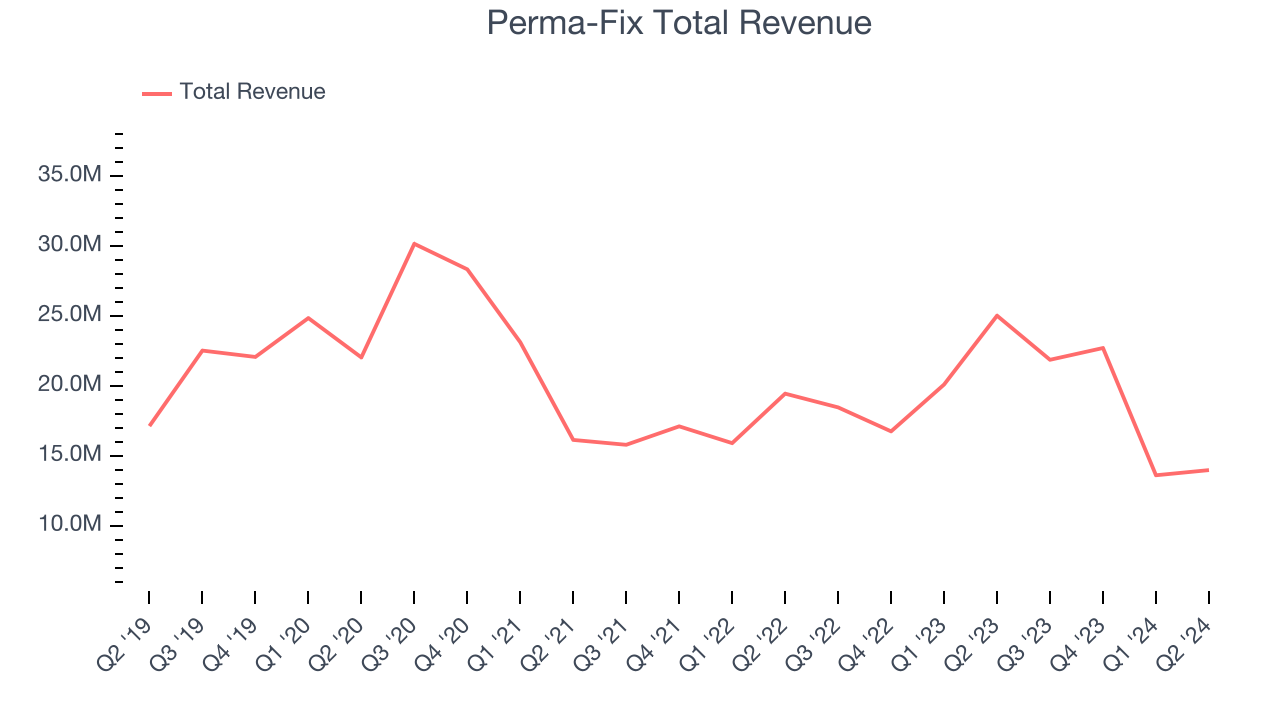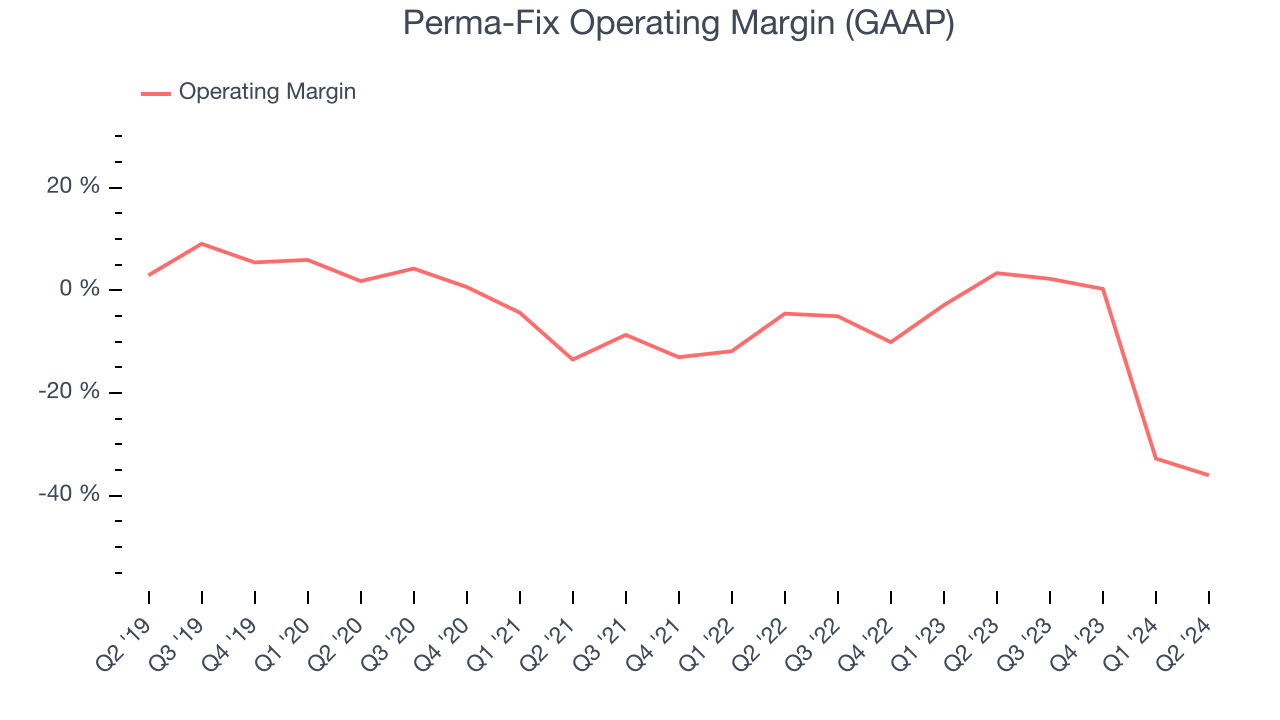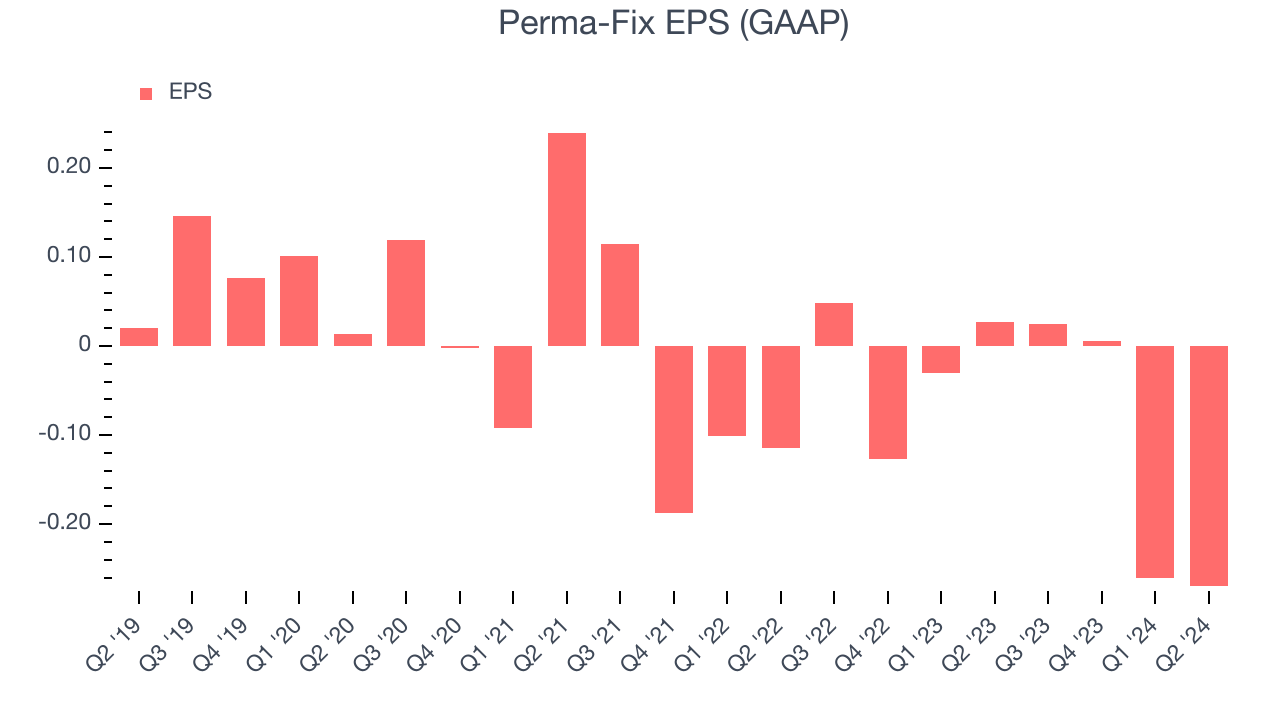Environmental waste treatment and services provider Perma-Fix (NASDAQ:PESI) fell short of analysts' expectations in Q2 CY2024, with revenue down 44.1% year on year to $13.99 million. It made a GAAP loss of $0.27 per share, down from its profit of $0.03 per share in the same quarter last year.
Is now the time to buy Perma-Fix? Find out by accessing our full research report, it's free.
Perma-Fix (PESI) Q2 CY2024 Highlights:
- Revenue: $13.99 million vs analyst estimates of $15.9 million (12% miss)
- EPS: -$0.27 vs analyst estimates of -$0.16 (-$0.11 miss)
- Gross Margin (GAAP): -9.3%, down from 18% in the same quarter last year
- EBITDA Margin: -32.9%, down from 5.9% in the same quarter last year
- Market Capitalization: $161.2 million
Mark Duff, President and CEO of the Company, commented, “Our second quarter performance remained weak due to ongoing government delays in waste shipments, awarding new task orders and procuring other projects. We also experienced an extended equipment failure at one of our facilities that adversely impacted our revenue and overall performance. Nevertheless, we believe that these are temporary issues. We are encouraged by the trends heading into Q3, driven by our increasing backlog and bidding activities along with progress we believe is being made on our long-term growth initiatives.”
Tackling hazardous waste challenges since 1990, Perma-Fix (NASDAQ:PESI) provides environmental waste treatment services.
Waste Management
Waste management companies can possess licenses permitting them to handle hazardous materials. Furthermore, many services are performed through contracts and statutorily mandated, non-discretionary, or recurring, leading to more predictable revenue streams. However, regulation can be a headwind, rendering existing services obsolete or forcing companies to invest precious capital to comply with new, more environmentally-friendly rules. Lastly, waste management companies are at the whim of economic cycles. Interest rates, for example, can greatly impact industrial production or commercial projects that create waste and byproducts.
Sales Growth
Reviewing a company's long-term performance can reveal insights into its business quality. Any business can have short-term success, but a top-tier one tends to sustain growth for years. Over the last five years, Perma-Fix grew its sales at a weak 4.4% compounded annual growth rate. This shows it failed to expand in any major way and is a rough starting point for our analysis. 
We at StockStory place the most emphasis on long-term growth, but within industrials, a half-decade historical view may miss cycles, industry trends, or a company capitalizing on catalysts such as a new contract win or a successful product line. Perma-Fix's recent history shows its demand slowed as its annualized revenue growth of 2.8% over the last two years is below its five-year trend.
This quarter, Perma-Fix missed Wall Street's estimates and reported a rather uninspiring 44.1% year-on-year revenue decline, generating $13.99 million of revenue. Looking ahead, Wall Street expects sales to grow 20.8% over the next 12 months, an acceleration from this quarter.
Here at StockStory, we certainly understand the potential of thematic investing. Diverse winners from Microsoft (MSFT) to Alphabet (GOOG), Coca-Cola (KO) to Monster Beverage (MNST) could all have been identified as promising growth stories with a megatrend driving the growth. So, in that spirit, we’ve identified a relatively under-the-radar profitable growth stock benefitting from the rise of AI, available to you FREE via this link.
Operating Margin
Operating margin is one of the best measures of profitability because it tells us how much money a company takes home after procuring and manufacturing its products, marketing and selling them, and, most importantly, keeping them relevant through research and development.
Unprofitable industrials companies require extra attention because they could get caught swimming naked if the tide goes out. It's hard to trust that Perma-Fix can endure a full cycle as its high expenses have contributed to an average operating margin of negative 3.5% over the last five years. This result isn't too surprising given its low gross margin as a starting point.
Analyzing the trend in its profitability, Perma-Fix's annual operating margin decreased by 18 percentage points over the last five years. The company's performance was poor no matter how you look at it. It shows operating expenses were rising and it couldn't pass those costs onto its customers.

In Q2, Perma-Fix generated an operating profit margin of negative 36%, down 39.4 percentage points year on year. Since Perma-Fix's operating margin decreased more than its gross margin, we can assume the company was recently less efficient because expenses such as sales, marketing, R&D, and administrative overhead increased.
EPS
Analyzing long-term revenue trends tells us about a company's historical growth, but the long-term change in its earnings per share (EPS) points to the profitability of that growth–for example, a company could inflate its sales through excessive spending on advertising and promotions.
Perma-Fix's earnings losses deepened over the last five years as its EPS dropped 16.7% annually. We tend to steer our readers away from companies with falling EPS, where diminishing earnings could imply changing secular trends and preferences. If the tide turns unexpectedly, Perma-Fix's low margin of safety could leave its stock price susceptible to large downswings.

In Q2, Perma-Fix reported EPS at negative $0.27, down from $0.03 in the same quarter last year. This print missed analysts' estimates. Over the next 12 months, Wall Street is optimistic. Analysts are projecting Perma-Fix's EPS of negative $0.50 in the last year to reach break even.
Key Takeaways from Perma-Fix's Q2 Results
We struggled to find many strong positives in these results. Its revenue and EPS fell short of Wall Street's estimates, and its gross margin was negative once again. Overall, this quarter could have been better. The stock remained flat at $10.11 immediately following the results.
Perma-Fix may have had a tough quarter, but does that actually create an opportunity to invest right now? When making that decision, it's important to consider its valuation, business qualities, as well as what has happened in the latest quarter. We cover that in our actionable full research report which you can read here, it's free.
